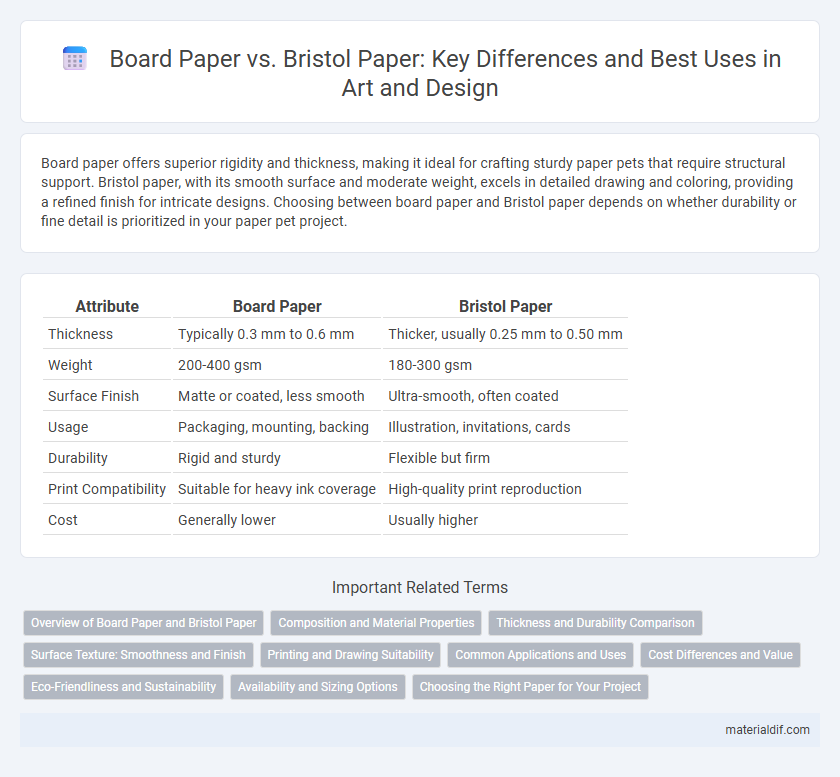Board paper offers superior rigidity and thickness, making it ideal for crafting sturdy paper pets that require structural support. Bristol paper, with its smooth surface and moderate weight, excels in detailed drawing and coloring, providing a refined finish for intricate designs. Choosing between board paper and Bristol paper depends on whether durability or fine detail is prioritized in your paper pet project.
Table of Comparison
| Attribute | Board Paper | Bristol Paper |
|---|---|---|
| Thickness | Typically 0.3 mm to 0.6 mm | Thicker, usually 0.25 mm to 0.50 mm |
| Weight | 200-400 gsm | 180-300 gsm |
| Surface Finish | Matte or coated, less smooth | Ultra-smooth, often coated |
| Usage | Packaging, mounting, backing | Illustration, invitations, cards |
| Durability | Rigid and sturdy | Flexible but firm |
| Print Compatibility | Suitable for heavy ink coverage | High-quality print reproduction |
| Cost | Generally lower | Usually higher |
Overview of Board Paper and Bristol Paper
Board paper is a heavyweight, rigid paper ideal for packaging, product displays, and crafting due to its high durability and thickness, typically ranging from 200 to 600 gsm. Bristol paper, a type of smooth, uncoated paperboard, features a fine finish and is commonly used for illustration, invitations, and business cards, usually available in two-ply or three-ply forms with thickness between 250 and 400 gsm. Both papers differ significantly in texture, weight, and intended applications, making board paper more suited for structural uses and Bristol paper preferred for detailed graphic work.
Composition and Material Properties
Board paper features a thicker composition with multiple layers of pulp, providing superior stiffness and durability compared to Bristol paper. Bristol paper is made from fine, high-quality cotton or wood pulp fibers, resulting in a smooth, dense surface ideal for detailed artwork and printing. The material properties of board paper emphasize rigidity and structural support, while Bristol paper prioritizes a balanced weight and texture suitable for fine drawing and illustration.
Thickness and Durability Comparison
Board paper typically ranges from 0.3 mm to 0.5 mm in thickness, offering moderate rigidity suitable for packaging and crafting. Bristol paper, often between 0.25 mm and 0.4 mm thick, provides a smoother surface while maintaining high durability for detailed art and printing projects. The denser composition of board paper enhances its stiffness, whereas Bristol paper's layered pulp structure delivers superior tear resistance and surface strength.
Surface Texture: Smoothness and Finish
Board paper features a slightly rougher surface texture compared to Bristol paper, offering enhanced rigidity and thickness suitable for packaging and presentation. Bristol paper boasts a superior smoothness and a polished finish, ideal for detailed illustrations, ink, and marker work that demand a clean, crisp appearance. The fine surface of Bristol paper ensures less ink bleed and sharper image reproduction, making it preferred for high-quality artistic and printing applications.
Printing and Drawing Suitability
Board paper offers excellent stiffness and durability, making it ideal for high-quality printing projects requiring a firm surface and longevity, but its rougher texture can limit fine detail in drawing. Bristol paper, characterized by its smooth, heavyweight finish, excels in detailed drawing and fine line work, while also supporting various printing techniques with superior ink absorption and minimal bleeding. Both papers cater to different artistic and printing needs, with board paper favored for packaging and posters, and Bristol paper preferred for precise illustrations and professional-grade prints.
Common Applications and Uses
Board paper is commonly used for packaging, book covers, and mounting artwork due to its rigidity and thickness, which provides durability and protection. Bristol paper is preferred for detailed illustration, drawing, and greeting cards because of its smooth surface and ability to hold ink and pencil without bleeding. Both papers serve distinct purposes based on their texture and weight, with board paper excelling in structural support and Bristol paper favored for fine art applications.
Cost Differences and Value
Board paper typically costs more than Bristol paper due to its thicker, sturdier composition and higher weight, which offers enhanced durability and premium quality for professional projects. Bristol paper provides a cost-effective alternative with a smooth surface suitable for detailed artwork and printing, making it ideal for budget-conscious applications. Despite the higher price, board paper's value lies in its rigidity and superior robustness, justifying the investment for long-lasting and high-end presentations.
Eco-Friendliness and Sustainability
Board paper typically has a higher environmental impact due to its heavier weight and often lacks eco-certifications, whereas Bristol paper is frequently produced from sustainably sourced fibers and recycled materials, enhancing its eco-friendliness. Bristol paper's smooth surface and durability allow for longer-lasting use, reducing waste and contributing to sustainability efforts. Choosing Bristol paper with FSC or PEFC certification supports responsible forestry practices and lowers the carbon footprint compared to conventional board paper.
Availability and Sizing Options
Board paper offers limited sizing options, typically available in larger standard dimensions such as 22x28 inches and often comes in bulk quantities for commercial use. Bristol paper provides a wider range of sizes, including common sheet sizes like 9x12 and 11x14 inches, making it more accessible for artists and crafters. Availability of Bristol paper is generally higher in retail stores, while board paper is more specialized and frequently sourced through art supply distributors.
Choosing the Right Paper for Your Project
Board paper offers superior rigidity and thickness, making it ideal for packaging, mounting, and crafts that require durability. Bristol paper, known for its smooth surface and lighter weight, excels in detailed artwork, illustrations, and printing projects. Selecting the right paper depends on project requirements: use board paper for structural support and bristol paper for precision and fine detail work.
Board paper vs Bristol paper Infographic

 materialdif.com
materialdif.com